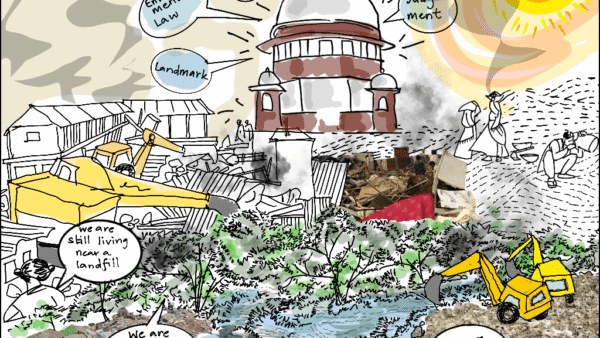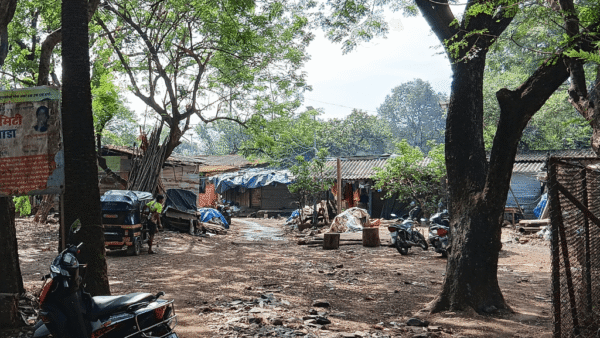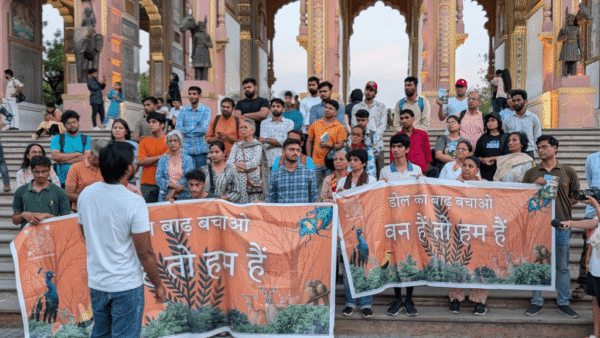What can 250 metres of space do for children? Give happiness. This thought set in motion a sequence of actions that transformed the space initially in front of DAV School in Vasant Kunj, Delhi, and later about 10 kilometres in front of 10 schools across the city. This space has become poetry in action, built a world of friendships, and fuelled compassion and a sense of belonging among school-going children.
The streets are spaces where children are invisibilised, a mirror of the society in which children mostly lack voice, visibility and agency. The implications are sobering because 40 percent of India’s population is below 18 years of age and at least 248 million go to school.[1] On the streets in India’s cities, nearly 45 children are killed or injured every day due to road traffic fatalities – that’s one classroom of children eliminated in a single day. Millions of children are pushed into everyday risks and disabilities, and poor mental health, caused by poor planning and design of urban infrastructure. This starts with our streets.
So, streets are where our repair would have to start too. This propelled my social change idea called Crosswalk when I was selected as a Dalai Lama Fellow in 2018. My purpose was to draw on the agency of children, couple it with their quirky and playful worldview, and evolve a meaningful and compassionate co-design of their spaces to make them safe and community-centred. Work started with a classroom of Grade 4 students of the DAV School in Vasant Kunj in 2019 and, by this year, the ‘250 metres of Happiness’ model has been embraced by 10 schools – eight government and two private – touching nearly 25,000 students in all.
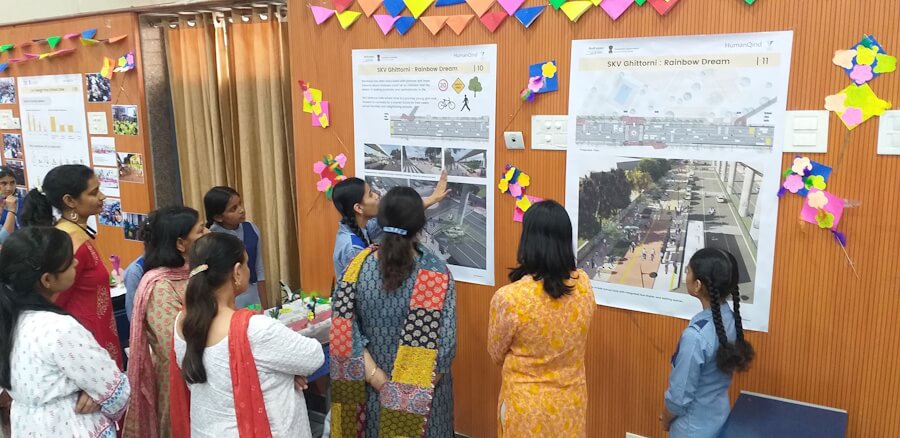
What is 250 metres of Happiness?
It is more than a co-created space – it is a testament to what can be created if students are co-designers. For the schools, it gives the right of way with vehicles at only 20 kilometres per hour, marked drop-off and pick-up points, table top crossings, segregated footpaths with tactile guiding blocks, segregated cycling tracks, specific signages, demarcated places for all utilities. In a nutshell, the way public spaces around schools should have been anyway.
There are also places for vendors, for pausing and sitting, for waiting and cycle parking which are integrated with play areas, open gyms, a linear park and landscaped zones. The ‘Tile of Love’ on the footpath tells the story of that street. Street art about ‘Safety Promise’ and new trees planted add to the vibe. This, after school hours and on weekends, is a community space that people in the area use and interact with, a space for social connections. This, I would call, is an infrastructure of care and compassion.
Schools are microcosms of their neighbourhoods. For the young, school is where they experience life beyond their family. Going to school becomes a journey in itself, where they learn life skills, build competencies, and negotiate the space they find themselves in. If schools are second homes for children, then the space around the schools matters and we must pay attention to it.
Today, schools need to look beyond their built boundaries and become the heartbeat of their communities. The Right to Education mentions the distance or proximity to access schools based on the age of children. Reimagining this access space, co-designing it with the children, turning it into a joyful and safe place for all in the community can redefine the school-going experience.
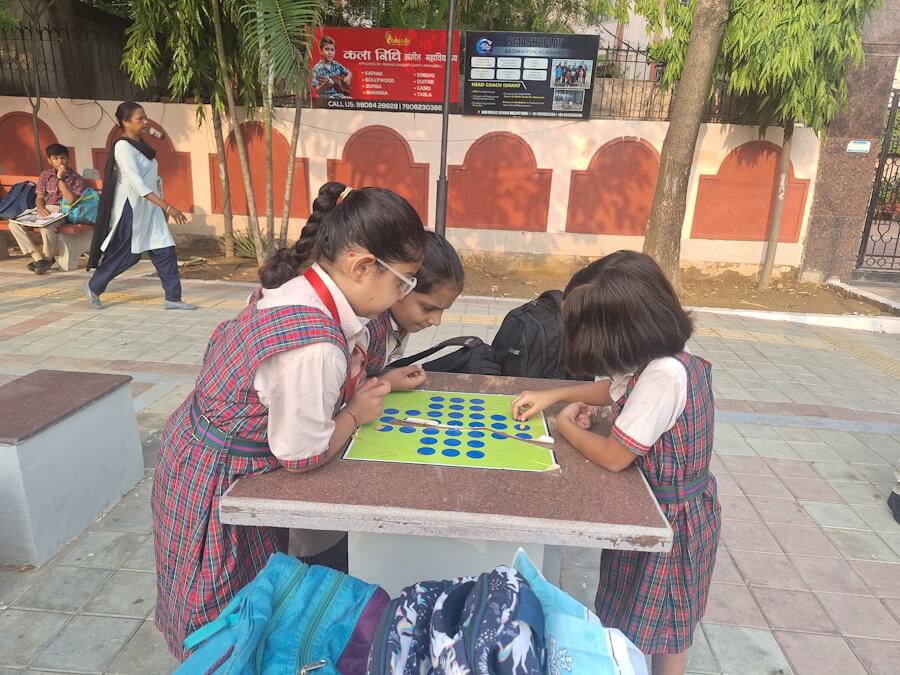
How we built it
The ‘250 meters of Happiness’ has now spread across 7,000 square metres of public space in four schools of Delhi. In the DAV School, we held a series of nine co-design workshops with the Grade 4 students. They were made familiar with human-centred design through play, art and science. Then, they were guided to reimagine their crosswalks to make them safer and a collective school-going experience. This way, they defined their school zone based on their lived experiences, observations and aspirations. This blueprint was more compassionate than a top-down plan by adults.
The blueprint was taken around for building consensus and collaboration from multiple stakeholders in the school, the neighbourhood, elected representatives and government. This was done in parents’ workshops, alumni meetings, staff engagements, and community exhibitions all anchored by a core school council comprising principal, lead teacher, parents and students so that ‘250 meters of Happiness’ becomes a shared vision of the community.
The Public Works Department then took it up for construction in 2022. Now, four schools or one school zone have their ‘250 metres of Happiness’ making the zone safer and bringing together the communities through children’s perspective. The Resident Welfare Association and city volunteers supported it; the district road safety committee monitored it and Delhi’s traffic police worked out the traffic management strategy. In a sense, students have reclaimed the space with help from illustrators and artists who have made street art to symbolise love and friendship.
This simple vision of creating 250 metres of happiness in a school zone in an interdisciplinary way is what we call HumanQind. The TRIP Centre at IIT Delhi, Delhi’s transport department, and Echoing Green now partner this. With 10 schools, we reckon that at least 25,000 students have been touched and children co-designers have become their community’s storytellers. The ‘250 metres of Happiness’ story continues to evolve.
HumanQind has followed this approach in every case. The 90-minute workshops are critical to this. The children bring their curiosity and active presence, share their mental maps, feel sad around cars, think of their mates with special needs, and are willing to send postcards to government officials. Then, a small group takes their vision to the entire school and everyone votes. It is amazing to see children playfully yet intentionally get everyone to back their dream. Then, the authorities step in.
HumanQind, in partnership with the TRIP Centre of IIT Delhi, is currently working with all districts in Delhi as part of the government’s safe school zone initiative. We have witnessed the changes in the lives and lived experiences of students across the 11 geographies on varied street and school typologies. The message is clear –the city, its people and its systems will be better, safer and kinder for all when we partner with children.
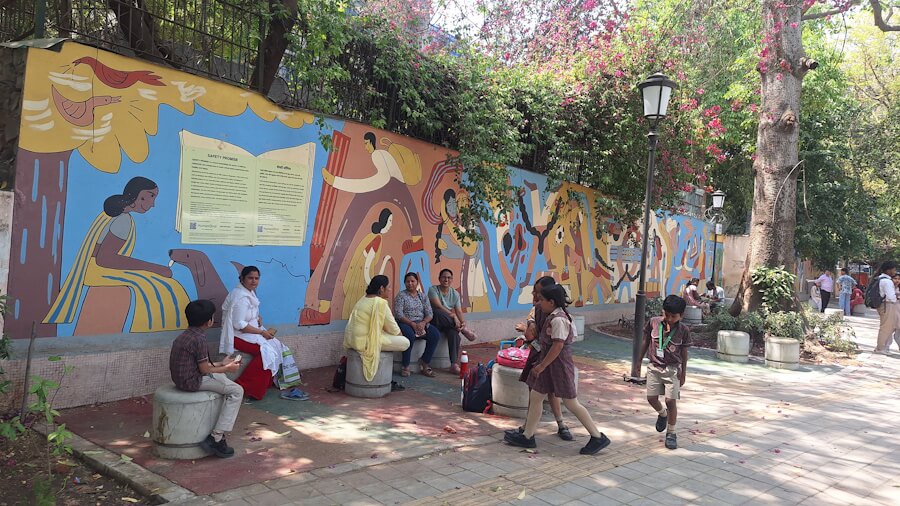
Why children’s point of view is important
Children question the status quo, why city environments are so fast paced, why they have been forgotten, why their childhoods are marginalised. Their schools shut down if there are floods and heat waves, during pollution, keeping them away from their friends and happiness. They want to cycle to school but cannot for the fear of being run over. All this questions our urban development paradigm and the gap between pedagogy and action.
Children are also bothered by conflicts – from far-away wars to speeding vehicles threatening them. They see how easily violence finds a place in our lives. Conflicts give them a message that lacks care and warmth for others, they witness fear in the eyes of their parents and internalise it, the uncertainty leads to anxiety and helplessness. From our group of co-designers, a girl asked what was happening to children in the Ukraine war or in Gaza. Her concern was legitimate.
To them, the world is a family of friends; they do not see race, colour, caste, ethnicity or religion as much as adults do. Their vision includes other species too. In the workshops, we find that children are surprised but elated that someone has come to ask their views and seek partnership. Children in adult spaces with the fear of being hit and disabled for life, children from low-income families who see school streets as their playground – their views matter because this is how the city speaks to them, invites them to partner or excludes them. It teaches us to base our work in care, joy, and dignity.
The project is also driven by the need to reimagine systems. The school-going experience has been limited to schools as learning spaces with two different systems of commutes. Mostly, school commutes are designed for vehicular mobility which is reflected in school transport policies with investments in school buses and vans. Private schools rely on designated buses but absolve responsibility as soon as a student is outside the school gate. Both are faulty and call for a new order.
The Delhi government has now institutionalised road safety clubs across schools; our project facilitates this. We have found that unlike planning in silos, children think of the whole. They care for strangers on streets and the lives of their caregivers, girls in one government school asked for an animal-friendly school zone, and imagined spaces for stray dogs and cats to eat healthy food rather than waste. This is designing with care and compassion.
Students are taught road safety but spaces are not designed for this. So, we made our work non-didactic but experiential and immersive. For girls and boys in schools with different timings, the point of interaction is the school zone, the street outside. Planning their school environments together gives them purpose and meaning. So, the 250 metres of space matters in many ways.
Scaling up the model
The ‘250 metres of Happiness’ can be replicated in other cities. In fact, every city with schools should have school zones that are designed and built for the safety, care and joy of children who come to the schools. The process is agile enough to be taken to any city. It will work because it brings together the hand, head and heart – it is evidence based (head), context adaptive (hand), and invests in co-creation and happiness (heart) to improve mobility, safety and lived experiences.
Subtly, the design can also have co-benefits such as curbing pollution and reducing heat in the area, making active mobility a priority, cultivating citizenship and participation from a young age, and demonstrating to children that change can be made with collective effort. City officials and municipal commissioners are always looking for solutions that demonstrate effective public spending and enhance the quality of life – this model offers a way to impact the young and their communities.
India is the crash capital of the world and road safety is now a concern. Road safety, fatality and disability statistics reveal that pedestrians and cyclists are highly vulnerable. But cities are planned around vehicles and this marginalises children. Our model allows schools and communities to reclaim their immediate spaces and make them meaningful for all. Incidentally, road safety also gets addressed. The Supreme Court committee on road safety has directed states to ensure and monitor road safety projects; traffic police are creating traffic management blueprints with schools.
What the ‘250 metres of Happiness’ shows is that if given a seat at the table, children can show how spaces and communities can flourish. When the project started, who could have imagined that students of neighbouring schools divided by different education systems can be friends, or students and parents of different age, caste, religion, abilities could come together to address real-world challenges with empathy and warmth?
Ruchi Varma is the founder and CEO at HumanQind, an award winning, compassion-centered design non profit helping children design their world of care, safety and well-being. She is a social innovator, livable cities expert and a public space alchemist exploring new forms of community investments to drive intergenerational and intersectional impact, with children. A flaneuse at heart, she loves exploring cities, public spaces and their everyday life. HumanQind has received numerous accolades including the Best Paper (Practice Stream) award at the World Safety Conference 2020, global honour at the UN World Urban Forum 2020, and the FICCI Road Safety Award 2023.
Photos: HumanQind


